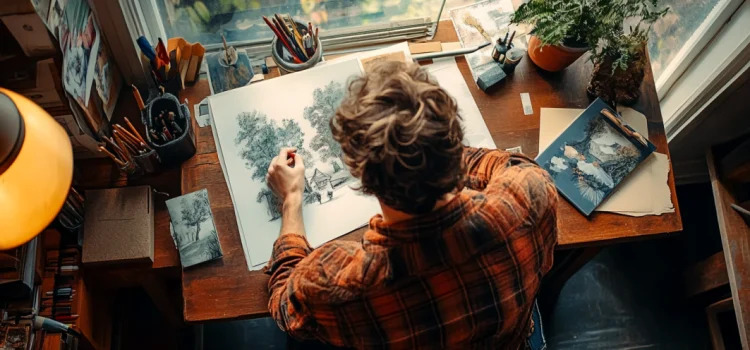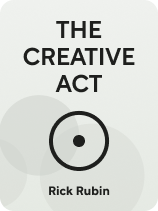

This article is an excerpt from the Shortform book guide to "The Creative Act" by Rick Rubin. Shortform has the world's best summaries and analyses of books you should be reading.
Like this article? Sign up for a free trial here.
What are the four steps of the creative process? Should the steps be done in order?
Music producer Rick Rubin believes that the creative process contains four steps: gather, experiment, craft, and complete. These creative stages aren’t linear and it’s normal to jump back and forth between them.
Continue reading for a closer look at the creative process.
The Creative Process
According to Rick Rubin in his book The Creative Act, there are four stages to the creative process: gathering, experimenting, crafting, and completing.
| The Broad Applications of the Creative Process Rubin’s four-stage creative process—gathering, experimenting, crafting, and completing—extends far beyond traditional art. It’s a universal framework that you can apply to nearly any field or situation where innovation is required. For instance, in business, gathering might involve collecting market data or brainstorming ideas; experimenting could be testing these ideas through prototypes or trial runs; crafting involves refining the product or strategy based on feedback; and completing means finalizing the project and launching it to the market. This approach is echoed in Tom Kelley and Jonathan Littman’s The Art of Innovation where they reveal how IDEO, a renowned design firm, fosters innovation through a methodology that includes deep user observation (akin to gathering), rapid prototyping (experimenting), iterative refinement (crafting), and implementation (completing). By understanding this process as a broader mechanism for engaging with the world creatively, you unlock potential applications in everyday problem-solving tasks, strategic planning in business settings, or even personal development. |
Stage 1: Gathering (Seed Phase)
In the gathering stage, which Rubin calls the “seed phase,” you collect inspirations, ideas, and materials that will feed into your work. This stage is about being open to everything around you and absorbing influences. It’s not yet about making decisions but about exposure to as wide a range of stimuli as possible. Think of it as laying the groundwork or planting seeds that have the potential to grow in various directions.
(Shortform note: In the gathering stage, consider using tools like a bullet journal or a commonplace book. These allow you to record ideas and inspiration as they come and to organize them in a way that makes sense for your creative process. By jotting down thoughts, quotes, sketches, and observations, you create a rich resource that you can return to when you move into more focused stages of your work. This practice ensures that the seeds planted during this initial gathering stage are preserved and ready to sprout when needed.)
Stage 2: Experimentation
Following the collection of ideas comes experimentation. In this phase, you begin playing with the ideas you’ve gathered—mixing them, matching them, testing out different combinations without concern for coherence or finality. This is a crucial part of discovering what works and what doesn’t, often leading to unexpected breakthroughs or new directions for your work.
(Shortform note: Google famously allows its employees to use 20% of their work time to explore new ideas and experiment, a policy that has led to successful projects like Gmail and AdSense. This approach underscores the importance of setting aside time for unstructured exploration, which can lead to significant breakthroughs and innovations.)
Stage 3: Crafting
After experimenting with various ideas and identifying promising avenues, you enter the crafting phase. Here, says Rubin, you shift your focus toward refinement and development—taking those rough concepts discovered during experimentation and shaping them into something more coherent and tangible. Attention to detail becomes paramount as you work on honing your project’s structure, aesthetics, or functionality depending on your medium.
(Shortform note: Editing your work can be challenging due to the emotional attachment you developed during the creative process. This attachment can cloud your judgment, making it difficult for you to identify and address weaknesses. The advice to “kill your darlings,” often attributed to William Faukner, encourages you to critically examine the most beloved elements of your work, and be willing to remove them if necessary. Adopting this ruthless objectivity can help you see your work as a cohesive whole rather than a collection of favorite parts. It lets you identify and eliminate weaknesses, repetitions, and inconsistencies that might otherwise remain hidden behind personal preference, ultimately making it more effective.)
Stage 4: Completing
The final stage is all about bringing your project across the finish line—completing it. This involves final adjustments like editing for clarity or consistency in written works, fine-tuning balance in music, adding last touches in visual arts, and so one to ensure everything aligns with your vision. It’s also about recognizing when to stop tweaking, understanding that perfection might be an impossible target and that completion itself is a significant achievement.
| Do Deadlines Help or Hurt? Deadlines play a complex role when completing projects, offering both benefits and potential drawbacks. Proponents of traditional project management, such as those following the Project Management Institute’s guidelines, often argue that deadlines create urgency, boost productivity, help prioritize tasks, and combat procrastination. They suggest that meeting deadlines can provide a sense of accomplishment, motivating further progress. However, critics of rigid deadline structures, including productivity expert Brian Tracy (Eat That Frog!), contend that strict deadlines can cause stress and anxiety, potentially hindering creativity and work quality. Tracy and others in this school of thought argue that focusing too much on deadlines may lead to rushed compromises in the final stages of a project. Daniel Pink, author of When, argues the effectiveness of deadlines largely depends on how they are set and managed. Well-planned deadlines can provide structure and motivation, while poorly implemented ones can harm project outcomes. To maximize benefits, many experts recommend that deadlines should be realistic and achievable, flexible when necessary, and balanced with quality considerations. |
Rubin emphasizes that these stages of the creative process aren’t strictly linear—you might find yourself moving back to gather more information after experimenting or returning to experimentation even within the crafting phase as new insights emerge.
Everything in the universe, including your creative work, is in a constant state of flux and evolution. Rubin encourages you to accept and embrace the impermanent nature of your work and ideas, highlighting the importance of being adaptable and open to change in the creative process. This perspective suggests that there’s always room for refinement and improvement in creative work, and your (and others’) understanding and interpretation of your work can change over time, offering new insights.
(Shortform note: Rubin’s perspective on embracing the fluidity and impermanence in the creative process is rooted in the Buddhist concept of impermanence and challenges the Western emphasis on static success and tangible outcomes. Instead of viewing creativity as a linear journey with a fixed endpoint, accepting impermanence allows us to see creativity as a dynamic flow, where ideas evolve and “failures” become stepping stones. This shift not only enriches the creative endeavor but also aligns with a more holistic understanding of existence, where change is the only constant.)

———End of Preview———
Like what you just read? Read the rest of the world's best book summary and analysis of Rick Rubin's "The Creative Act" at Shortform.
Here's what you'll find in our full The Creative Act summary:
- Where creativity comes from and why it matters
- How to take inspiration from anywhere and everywhere
- A music producer’s advice for enhancing your creativity





